“The future belongs to those who prepare for it today,” said Malcolm X. This quote resonates deeply in the context of the global race for dominance in artificial intelligence. The competition is fierce, with nations vying to harness this transformative technology for economic and strategic advantage.
In 2017, the Chinese Communist Party announced its ambition to surpass the United States and become the world leader in AI by 20301. This declaration marked the beginning of a strategic push, characterized by a centralized, state-directed approach. Unlike the decentralized innovation networks in the West, China’s strategy emphasizes government-led initiatives and investments.
China’s efforts are evident in its rapid advancements in AI models and applications. For instance, Chinese open-source models like Zhipu AI’s ChatGLM3 have outperformed U.S. counterparts in specific capabilities2. Additionally, the government’s support through subsidies and spatial distribution of funds has fostered growth in less-developed regions2.
This article explores whether China’s unique approach can propel it to the forefront of the AI race. We will delve into the strategies, challenges, and global implications of this ambitious endeavor.
Key Takeaways
- China aims to lead in artificial intelligence by 2030.
- The state-directed approach contrasts with Western innovation models.
- Chinese AI models are rapidly closing the performance gap with U.S. counterparts.
- Government subsidies and spatial distribution of funds support AI development.
- The global AI race has significant economic and strategic implications.
Introduction to China’s AI Landscape

The race for AI dominance is heating up, with China making significant strides in innovation and development. The country’s approach combines state-led initiatives with market-driven forces, creating a unique ecosystem for artificial intelligence growth.
Overview of AI Developments
China’s AI landscape is marked by rapid advancements across various sectors. From healthcare to finance, artificial intelligence is transforming industries. For example, Baidu’s Apollo project leads in self-driving technology, while Tencent’s AI medical imaging is revolutionizing healthcare delivery3.
Government investment plays a crucial role in this progress. Federal, provincial, and local funding mechanisms, including direct grants and public-private partnerships, support AI development3. This centralized approach contrasts with the decentralized innovation networks in the United States.
Key Drivers in AI Adoption
State directives and market forces are the primary drivers behind China’s AI adoption. The government’s “New Generation Artificial Intelligence Development Plan” outlines a clear roadmap for achieving global leadership by 20303.
Research institutions and tech giants like Alibaba and Huawei are at the forefront of this push. Their contributions to large language models and generative AI are narrowing the performance gap with U.S. counterparts3.
China’s focus on ethical AI development, data privacy, and cybersecurity further shapes its strategy. Recent regulations, such as the Interim Measures for Generative Artificial Intelligence Service Management, highlight this commitment3.
For more insights into how AI is transforming industries, explore AI in finance.
Historical Evolution of Chinese AI Development
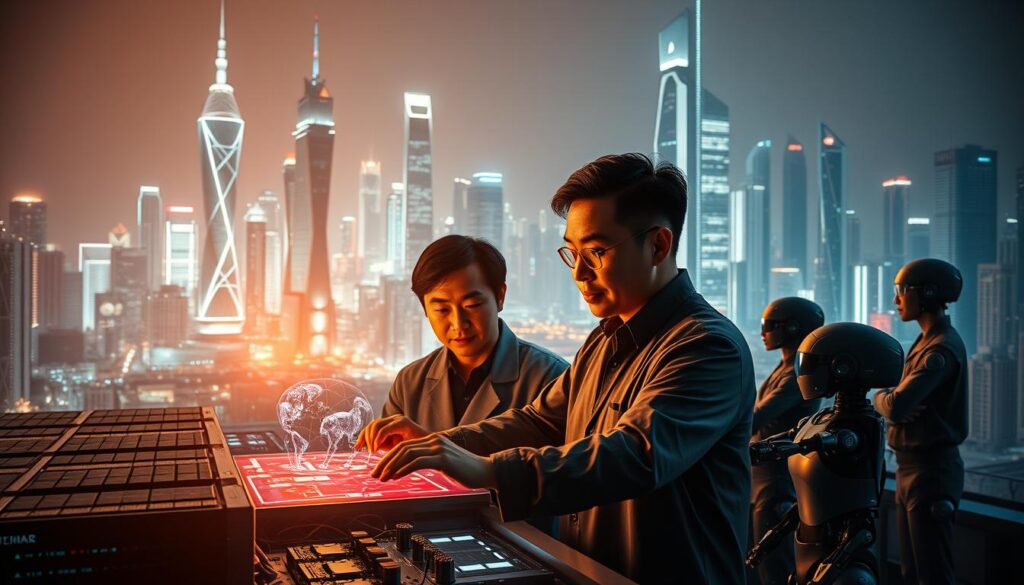
The journey of artificial intelligence in China has been shaped by decades of strategic planning and innovation. From its early stages to today, the country’s approach has evolved into a global powerhouse of technological advancement.
In 2016, the Chinese Communist Party outlined its ambition to lead in artificial intelligence by 2030, as part of its thirteenth five-year plan4. This marked a pivotal moment, setting the stage for a series of state-led initiatives. The government identified fifteen national AI teams, including tech giants like Baidu, Tencent, and Alibaba, to drive specialized sectors4.
Over the years, the focus has shifted from foundational technology to practical applications. For instance, Shanghai’s Pudong District became a hub for AI companies, with related industries valued at approximately 91 billion yuan by 20204. This growth was fueled by significant investments, such as the $2.1 billion allocated for an AI industrial park in Mentougou district in 20184.
Academic institutions and government programs have played a crucial role in this evolution. By 2023, 47% of the world’s top AI researchers had completed their undergraduate studies in China4. This talent pool has been instrumental in advancing research and development, particularly in areas like large language models and generative AI.
Key reports and regulatory milestones have also shaped the trajectory. The State Council’s 2017 Artificial Intelligence Development Plan set a target of building a 1 trillion yuan AI-powered economy by 20305. Additionally, the “Eastern Data, Western Computing” project, launched in 2022, aims to create a national integrated computing power network6.
China’s AI journey is a testament to the synergy between state objectives and technological innovation. As the country continues to push boundaries, its historical evolution offers valuable insights into the future of artificial intelligence.
Governmental Strategies and State Objectives

State-driven strategies are redefining the role of artificial intelligence in society. The central role of the government in directing AI development is evident in its focus on ideological and economic objectives. These efforts aim to align technological advancements with national goals.
Ideological and Social Control
Technologies like facial recognition and content regulation are key tools for maintaining control. For instance, the Xue Xi chatbot, developed by Tsinghua University, incorporates “Xi Jinping Thought” to promote Communist Party ideology7. This illustrates how AI is used for ideological indoctrination.
AI-driven surveillance systems are widely deployed, particularly in regions like Xinjiang, to monitor populations7. These measures ensure policy adherence and reinforce social stability.
Economic Planning and Efficiency
The state leverages AI to enhance economic planning and public efficiency. The social credit system, which rates citizens based on civic and financial behavior, is a prime example7. This system influences loan approvals, travel permissions, and more.
Government-led initiatives also focus on manufacturing and logistics. By integrating AI into these sectors, the strategy aims to boost productivity and streamline operations8.
| Strategy | Application | Impact |
|---|---|---|
| Ideological Control | Xue Xi chatbot, facial recognition | Promotes policy adherence |
| Economic Planning | Social credit system, manufacturing | Enhances efficiency |
These centralized approaches contrast sharply with the decentralized models seen in other nations. The intentional integration of technology and governance underscores the unique state objectives driving AI development.
Chinese AI in Economic Applications

Artificial intelligence is reshaping industries, driving economic growth, and transforming the way businesses operate. In the manufacturing and logistics sectors, advanced technologies are optimizing processes and enhancing efficiency. Companies like Alibaba are leading the charge with AI-driven solutions that streamline warehouse operations and delivery systems9.
Manufacturing and Logistics Innovations
AI-powered systems are revolutionizing manufacturing by improving precision and reducing waste. For example, Alibaba’s smart warehouses use robotics and machine learning to manage inventory and fulfill orders at unprecedented speeds9. These innovations not only boost productivity but also reduce operational costs, giving businesses a competitive edge in the global market.
In logistics, AI algorithms analyze vast amounts of data to optimize delivery routes and predict demand. This ensures faster and more reliable service, which is crucial for e-commerce platforms. The integration of AI across these sectors highlights its transformative power in driving economic growth.
Social Credit Systems and Data Analysis
AI plays a pivotal role in reinforcing China’s social credit system. By analyzing data streams from various sources, the system evaluates citizens’ behavior and assigns scores that influence access to loans, travel, and other services10. This approach not only promotes policy adherence but also enhances economic planning by providing actionable insights.
Data analysis is also critical for strategic decision-making in industries. Companies leverage AI to identify trends, forecast demand, and allocate resources efficiently. This integration of technology across multiple sectors strengthens the nation’s economy and positions it as a leader in the global market.
The broader implications of these advancements are significant. As AI continues to evolve, its applications in manufacturing, logistics, and data analysis will shape the future of the global economy. The industry is poised for further growth, driven by ongoing research and technological innovation.
Can China Use AI?

The strategic deployment of advanced technologies is reshaping global dynamics. A key question arises: can the nation effectively harness artificial intelligence to meet its goals? This inquiry delves into both technical and political challenges, offering a nuanced perspective on the matter.
One significant hurdle is the integration of large language models within controlled environments. These models, while powerful, must align with state regulations and ideological frameworks. For instance, the Cyberspace Administration of China has approved over 180 large language models for general use, ensuring compliance with national standards11.
The state’s approach emphasizes adaptation over pioneering innovation. This strategy addresses immediate national needs but raises questions about long-term competitiveness. For example, estimates suggest that China’s AI model development lags behind the U.S. by six to twenty-four months11.
Industry debates highlight whether this adaptation-focused model suffices for global leadership. While Chinese models like Baichuan3 are narrowing the performance gap with U.S. counterparts, they still trail in foundational research2. This contrast underscores the tension between practical applications and breakthrough innovations.
Key challenges include:
- Aligning AI development with political and ideological constraints.
- Bridging the gap in foundational research compared to Western models.
- Ensuring global competitiveness through strategic adaptations.
Despite these challenges, the state’s centralized approach has yielded significant progress. The broader AI ecosystem in China, characterized by a larger number of companies, continues to evolve11. This multifaceted landscape sets the stage for further exploration in the article.
Global Comparisons: China Versus the United States

The global race for technological supremacy is intensifying, with the United States and China leading the charge. Both nations are pursuing dominance in artificial intelligence, but their approaches differ significantly. This section explores the contrasting models of research and innovation that define their strategies.
Contrasting Research and Innovation Models
The United States operates on a decentralized, market-driven model. Universities like MIT and Stanford, alongside tech giants such as Google and Microsoft, drive breakthroughs like GPT-4 and PaLM12. This ecosystem thrives on private investment and a culture of pioneering innovation.
In contrast, China’s state-directed approach emphasizes centralized planning. The government identifies key sectors and allocates resources strategically. For example, companies like Baidu and Alibaba focus on large language models, supported by state funding12. This model prioritizes rapid deployment over foundational research.
The competition between these two approaches shapes global dynamics. While the U.S. leads in high-impact research, China is rapidly closing the gap by optimizing performance with fewer resources12. This rivalry drives advancements but also raises ethical questions about data usage and privacy.
For a deeper dive into how these models influence technological progress, explore reasoning advancements.
Technology Adaptation Versus Novel Innovation

The balance between adapting existing technologies and pioneering new innovations defines the modern technological landscape. While some nations focus on groundbreaking research, others prioritize refining and deploying current solutions to meet strategic goals.
Leveraging Existing Technologies
Adapting current tools has become a cornerstone of progress. For instance, Chinese firms have optimized large language models for everyday applications, ensuring practicality over originality1. This approach allows for rapid deployment and immediate benefits in sectors like healthcare and logistics.
Successful case studies highlight the advantages of this strategy. Cities with higher industrial robot densities have seen increased patent intensities, particularly in less innovative regions13. This demonstrates how leveraging existing technology can bridge gaps and drive growth.
Developing Robust Infrastructure
Building a strong foundation is essential for widespread adoption. Investments in infrastructure have enabled the integration of advanced systems across various industries. For example, the expansion of AI into inland provinces has spurred innovation in traditionally underserved areas13.
This focus on infrastructure supports economic and social objectives. By creating networks that facilitate the use of technology, nations can ensure sustainable development and long-term competitiveness.
While adaptation offers immediate benefits, it also raises questions about long-term leadership. The contrast between this approach and the West’s innovation-led model highlights the trade-offs involved. For more insights into technological advancements, explore AI tools.
AI for Surveillance and Social Control

The integration of advanced technologies into surveillance systems has reshaped societal dynamics globally. These systems play a critical role in maintaining order and enforcing policies, particularly in regions where social stability is a priority. The government leverages these tools to monitor behavior and regulate content, ensuring alignment with national objectives.
Facial Recognition Systems
Facial recognition technology is a cornerstone of modern surveillance. In regions like Xinjiang, these systems collect vast data points to detect potential dissidents before any concrete act is committed14. The Sharp Eyes program and the Integrated Joint Operations Platform are key initiatives for monitoring behavior indicative of social instability among minority populations14.
These technologies are designed to enhance control by identifying individuals who may pose a threat. However, their widespread use raises ethical concerns about privacy and human rights. The performance of these systems relies on advanced algorithms and extensive data analysis, which are continuously refined through ongoing research.
Content Regulation and Algorithmic Oversight
Algorithmic oversight is another critical aspect of social management. The Social Credit System (SCS) ranks citizens based on a range of social and behavioral data, integrating public and private information to evaluate daily behaviors14. This model ensures compliance with societal norms while providing actionable insights for policymakers.
Online content is also subject to strict regulation. AI-powered tools monitor and filter information in real-time, ensuring that only approved narratives are disseminated. For example, the “Peer Review” operation uses AI to track anti-government sentiments and generate real-time reports on dissident activities15.
These systems highlight the dual role of technology in both enforcing control and enhancing service delivery. However, they also present challenges, including the need for continuous updates to maintain effectiveness and address emerging threats.
Exporting AI for International Influence
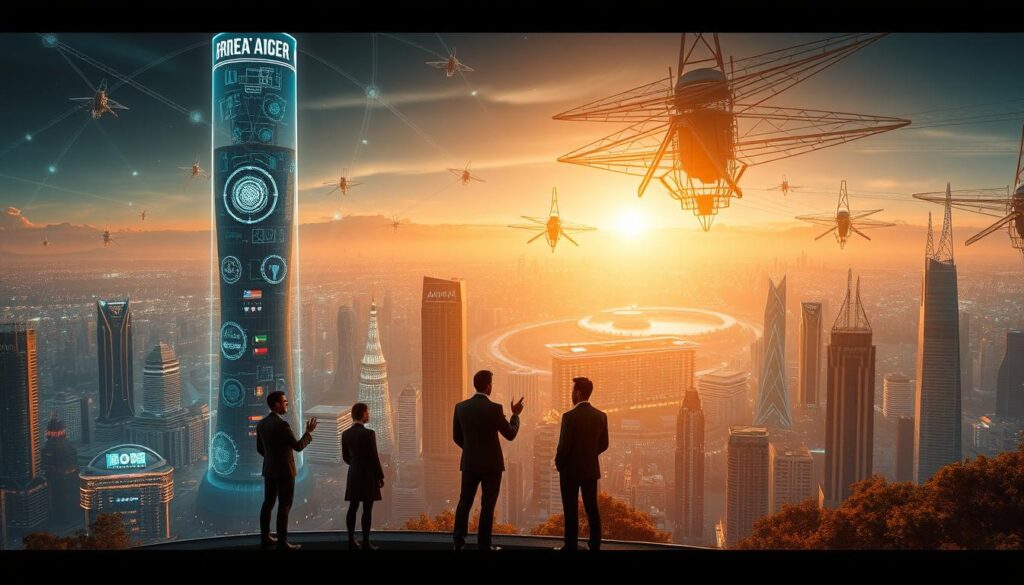
The global landscape of technology is being reshaped by strategic exports of advanced systems. These efforts are not just about economic gains but also about extending international influence. By leveraging cutting-edge tools, nations can position themselves as leaders in the global arena.
One of the most significant platforms for this strategy is the Belt and Road Initiative. This ambitious project serves as a conduit for exporting surveillance systems and other advanced technologies to developing nations. For example, firms like Huawei have implemented nationwide facial recognition systems in countries like Zimbabwe, raising both security and ethical concerns16.
Economic and Political Implications
Exporting state-controlled technology has far-reaching consequences. On the economic front, it strengthens ties with partner nations and opens new markets. Politically, it reinforces the exporter’s role as a global leader in innovation. However, it also raises questions about the balance between influence and ethical responsibility.
Key benefits of this strategy include:
- Strengthening international partnerships through shared technology.
- Enhancing the exporter’s reputation as a leader in innovation.
- Driving economic growth by expanding into new markets.
For more insights into how export controls impact global dynamics, explore this analysis.
Shaping International Standards
Leadership in technology exports also allows nations to shape global standards. By setting benchmarks for innovation and application, exporters can influence the direction of technological development worldwide. This strategic advantage ensures long-term benefits for the economy and solidifies their position as a global leader.
While export strategies focus on international influence, they also complement domestic applications. The synergy between these approaches creates a robust ecosystem for technological advancement, driving both local and global progress.
Military Applications and Autonomous Systems

The integration of advanced systems into military operations is transforming modern warfare. From autonomous drones to robotic platforms, these technologies are reshaping defense strategies and enhancing operational capabilities. The focus on intelligent machines is not just about innovation but also about gaining a strategic edge in sensitive regions like the South China Sea17.
Development of Drones and Robotics
Drones and robotics are at the forefront of military technology. The People’s Liberation Army (PLA) has developed operational concepts like system destruction warfare, which targets vulnerable links between sensors and platforms to disrupt enemy communication17. These systems rely on advanced models for precision and efficiency.
AI-enabled autonomous vehicles are also being tested for predictive maintenance and decision-making. For example, the PLA is exploring applications in missile guidance and electronic warfare, leveraging research to optimize performance17. These advancements highlight the dual-use nature of these technologies, serving both defense and domestic purposes.
Naval and Land-Based AI Systems
Naval and land-based systems are equally critical. The PLA’s multi-domain precision warfare integrates AI and big data analysis to exploit enemy weaknesses17. This approach ensures that power is concentrated where it matters most, enhancing strategic outcomes.
Land-based systems, such as autonomous machine gun platforms, are being developed for battlefield testing. These systems use AI for targeting and decision-making, showcasing the potential of intelligent technology in combat scenarios18. However, challenges remain, including the need for robust research and infrastructure to support these advancements.
The global race for military AI dominance is intensifying. While the U.S. remains a leader in research, the PLA’s centralized approach is narrowing the gap19. The future of warfare will likely depend on how effectively nations can integrate these systems into their defense strategies.
Chinese AI Regulations and Governance
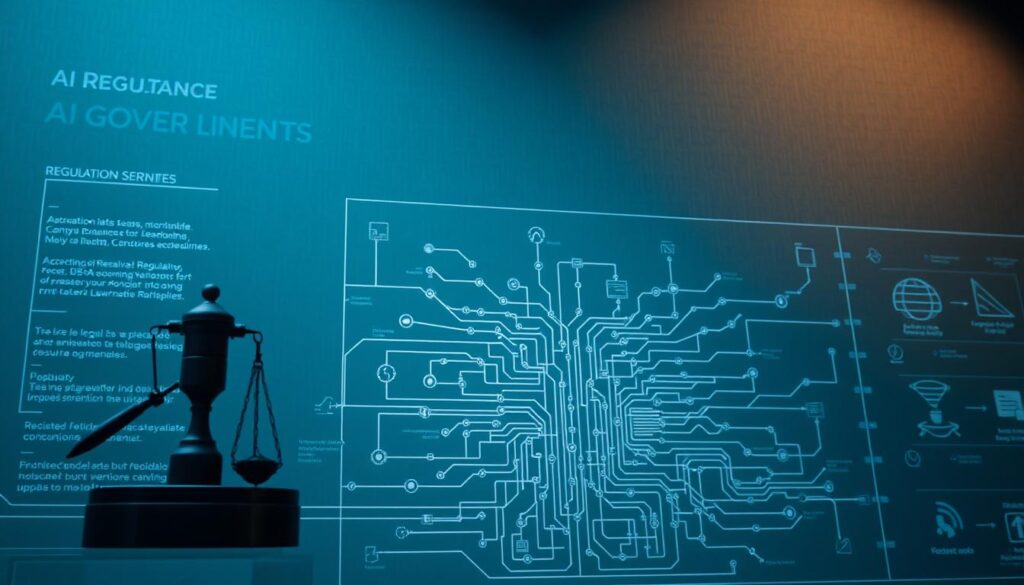
China’s approach to AI regulation sets a unique global precedent. The government has established a comprehensive framework to ensure control over technological advancements while fostering innovation. This framework includes stringent rules for algorithmic recommendations, deep synthesis, and generative AI, shaping both domestic and international applications.
Algorithmic Recommendation Policies
Algorithmic recommendation systems are tightly regulated to ensure transparency and fairness. Since March 1, 2022, companies using these systems must file their algorithms with the government for approval20. This measure aims to prevent misuse and ensure that recommendations align with national values.
Violations of these policies can result in severe penalties, including fines of up to 50 million RMB or 5% of annual revenue21. These regulations underscore the importance of compliance in maintaining public trust and operational integrity.
Deep Synthesis and Generative AI Rules
Deep synthesis and generative AI technologies are subject to strict oversight. Effective January 10, 2023, all AI-generated content must be clearly labeled to prevent misuse20. This includes both explicit and implicit labeling methods, ensuring transparency for users.
Generative AI service providers must also conduct security assessments if their services have public opinion attributes or social mobilization capabilities21. These measures ensure that AI-generated content aligns with socialist core values and avoids prohibited material.
| Regulation | Effective Date | Key Requirement |
|---|---|---|
| Algorithmic Recommendations | March 1, 2022 | Mandatory filing of algorithms |
| Deep Synthesis | January 10, 2023 | Clear labeling of AI-generated content |
| Generative AI | August 15, 2023 | Security assessments for public opinion services |
These regulations highlight the government’s commitment to balancing innovation with control. By setting clear standards, China aims to lead in the ethical development and deployment of advanced technologies.
Impact on the Economy and Power Consumption
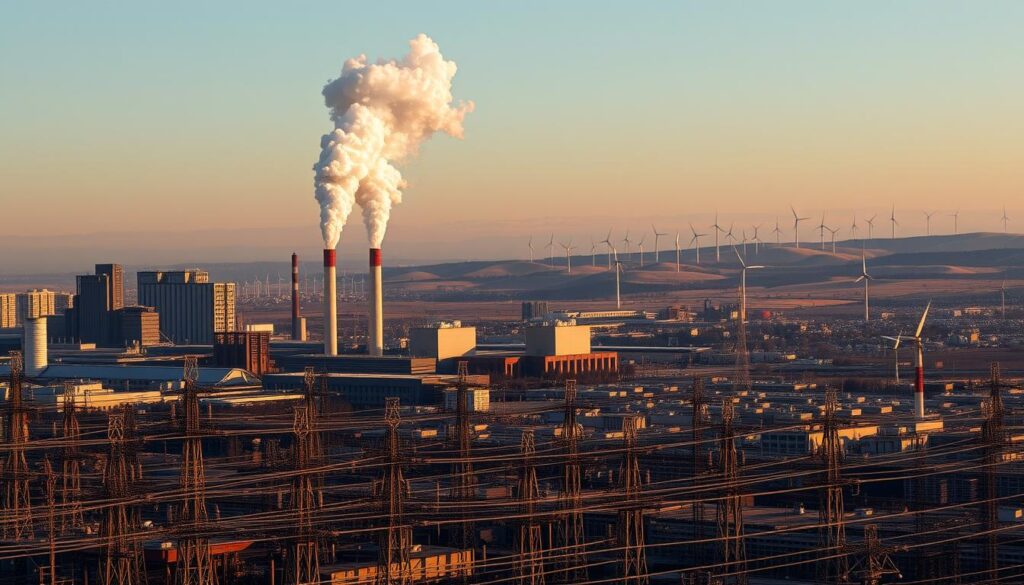
The rapid expansion of artificial intelligence is reshaping global energy demands. As AI adoption accelerates, its influence on power consumption and electrical infrastructure is becoming increasingly evident. This section explores the economic and energy-related challenges and opportunities driven by this technological shift.
Market Growth and AI Adoption Trends
The global market for AI technologies is experiencing exponential growth. In 2023, the value of the AI market is projected to reach $0.91 billion, with a growth rate of 82.5%22. This surge is fueled by investments in data centers and AI-driven applications, which are transforming industries worldwide.
However, this expansion comes with significant energy demands. Training a large language model (LLM) consumes energy equivalent to powering 130 U.S. homes for one year23. As AI adoption continues, the power required to support these technologies is expected to grow substantially.
Upgrading Electrical Infrastructure
The increasing energy needs of AI are putting pressure on electrical grids. Global data centers consumed 1.65 billion gigajoules of electricity in 2022, and this figure is projected to rise by 35% to 128% by 202623. To meet this demand, significant upgrades to infrastructure are essential.
China’s DeepSeek LLM, for example, uses 10 to 40 times less energy than U.S. AI technology, showcasing the potential for efficiency improvements23. Investments in smart grids and renewable energy sources are critical to sustaining this growth while minimizing environmental impact.
According to a report, the U.S. Infrastructure Investment and Jobs Act of 2021 includes the Grid Resilience and Innovation Partnerships (GRIP) Program, aimed at enhancing energy grid resilience23. Similar initiatives are needed globally to support the rising energy demands of AI.
The economic effects of these changes are profound. Upgrading infrastructure not only supports AI development but also creates opportunities for innovation and job creation. As the world embraces AI, balancing technological advancement with sustainable energy practices will be key to long-term success.
Sector Innovations: Healthcare, Automotive, and Beyond
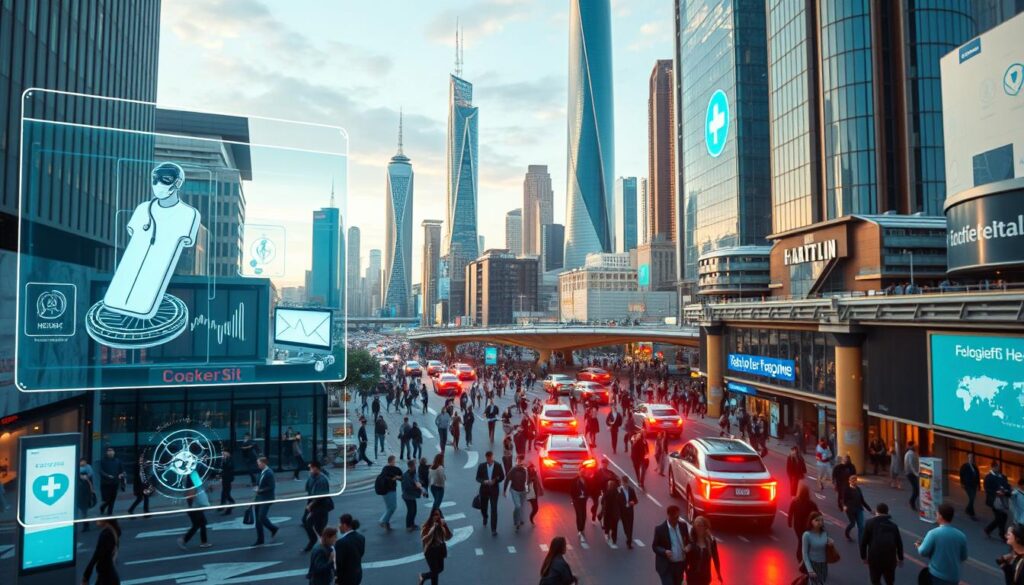
Innovations in healthcare and automotive industries are transforming how we live and work. Artificial intelligence is at the forefront of these changes, driving advancements that improve efficiency and outcomes. From medical imaging to autonomous vehicles, the impact of these technologies is profound.
AI in Medical Imaging and Drug Discovery
AI is revolutionizing healthcare, particularly in medical imaging and drug discovery. Tools like MedGPT are enhancing diagnostics, enabling faster and more accurate assessments24. This application of AI is reducing the time required for diagnosis and improving patient outcomes.
In drug discovery, AI algorithms analyze vast datasets to identify potential treatments. This innovation accelerates the development of new medications, addressing critical health challenges. Companies like Huawei are leading the way, integrating AI into their healthcare solutions25.
The industry is also benefiting from AI-driven telemedicine, which expands access to underserved areas. This approach reduces hospital congestion and ensures more equitable healthcare delivery24.
Autonomous Vehicles and Smart Transportation
In the automotive sector, AI is powering autonomous vehicles and smart transportation systems. Companies like Xiaomi are producing cars every 76 seconds using AI-guided robots25. This innovation is transforming manufacturing processes and enhancing productivity.
AI applications in satellite production have reduced production time from 1-2 years to just 28 days, achieving a 45% cost reduction25. These advancements are driving the industry toward broader automation and unmanned facilities.
Leading companies and research institutions are collaborating to develop cutting-edge solutions. For example, Nvidia’s Drive AI suite provides end-to-end solutions for autonomous vehicle manufacturers26. This model of collaboration is setting new standards for the sector.
| Sector | Key Innovations | Impact |
|---|---|---|
| Healthcare | Medical imaging, drug discovery | Improved diagnostics, faster treatment development |
| Automotive | Autonomous vehicles, smart transportation | Enhanced productivity, cost reduction |
The integration of AI into these critical sectors is shaping the future of technology. As research continues to drive advancements, the potential for growth and innovation remains limitless.
Technological Infrastructure and Data Centers
The backbone of modern technological advancements lies in robust infrastructure and efficient data centers. As the demand for processing power grows, the need for upgraded facilities becomes critical. Data centers are the lifeline of artificial intelligence, handling massive workloads and ensuring seamless operations.
Global electricity consumption is projected to reach 26,787 TWh in 2025, with data centers playing a significant role in this increase27. In Ireland alone, data centers consume one-fifth of the country’s electricity, and this figure is expected to grow27. The primary market supply of data centers in the United States increased by 26% year over year to 5.2 GW in 202327.
The strategic approach to upgrading infrastructure is essential to meet these demands. Advanced transmission technologies can increase power capacity on existing lines within one to two years28. However, new transmission builds may take a decade or more to plan, permit, and construct under current regulatory processes28.
Leading tech companies are investing heavily in infrastructure upgrades. OpenAI plans to build AI-specific data center campuses that will be multiple times larger than the largest existing data centers in the U.S28.. Similarly, a joint venture named Stargate is projected to invest upwards of $500 billion into AI infrastructure28.
| Investment | Focus Area | Impact |
|---|---|---|
| $500 billion | AI Infrastructure | Enhances global AI capabilities |
| $100 billion | Emerging Technologies | Drives innovation in AI |
| $20 billion | Data Centers | Expands processing capacity |
These efforts are underpinned by ongoing research and development. Nvidia’s new Grace Blackwell chips, for example, can train a large AI model using 2,000 chips in 90 days, consuming 4 MW, compared to 8,000 previous generation chips consuming 15 MW for the same task27. This innovation highlights the importance of efficient technology in reducing power consumption.
The future of AI depends on the continuous evolution of data centers and infrastructure. By focusing on robust technology and strategic investments, the global AI ecosystem can sustain its growth and meet the increasing demands of the digital age. For more insights into the tools driving these advancements, explore AI tools.
Future Outlook: Policy, Market, and Global Implications
The future of technology is being shaped by evolving policies and market dynamics. As nations race to harness the potential of advanced systems, the global landscape is set for significant transformation. This section explores the projected growth areas, challenges, and long-term strategic trends that will define the next decade.
Projected Growth Areas and Challenges
The global market for advanced technologies is expected to reach $3,527.8 billion by 2033, with an annual growth rate exceeding 30%29. This rapid expansion is driven by investments in sectors like healthcare, manufacturing, and finance. However, the challenge lies in balancing growth with sustainability, especially in energy consumption.
Chinese data centers are projected to account for nearly 6% of the nation’s total electricity demand by 202630. This highlights the need for efficient development strategies to minimize environmental impact. The competition for computing resources could further complicate efforts to achieve green transition goals30.
Long-Term Strategic Trends
State-led initiatives are expected to play a crucial role in shaping the future of technology. China’s $1.4 trillion investment plan for high-tech industries underscores its commitment to becoming a global leader31. This strategy focuses on fostering innovation while addressing societal needs, such as an aging population projected to reach 39% by 205030.
Long-term trends also include the integration of advanced systems into global markets. Export controls on high-end technologies, such as those imposed by the U.S., are likely to influence the flow of innovation31. These measures aim to protect national security but may also create barriers to collaboration.
Key goals for the future include:
- Enhancing infrastructure to support technological advancements.
- Addressing energy and resource challenges through sustainable practices.
- Fostering international partnerships to drive global innovation.
As the world navigates these complexities, the role of research and policy will be critical. By aligning strategy with emerging trends, nations can position themselves for success in the evolving technological landscape.
Conclusion
The multifaceted role of advanced technologies in shaping global dynamics underscores the importance of strategic adaptation. This article explored how state-driven objectives and technological performance intersect, highlighting the need for balance. From large language models to sector-specific innovations, the focus remains on achieving both efficiency and control.
Key players in this transformation include leading firms and sector pioneers, whose contributions drive progress. For example, initiatives like Lighthouse Factories have significantly reduced energy consumption and waste, showcasing the potential of targeted investments32. However, challenges such as data quality and computational limitations persist, shaping the future outlook.
As the global landscape evolves, the focus on sustainable development and ethical practices will remain critical. The integration of advanced technologies into various industries demonstrates their transformative potential. By addressing these challenges, the path forward will be defined by innovation, collaboration, and strategic foresight.
FAQ
What is the current state of AI development in China?
How does the Chinese government influence AI adoption?
What are the key applications of AI in China’s economy?
How does China compare to the United States in AI innovation?
What role does AI play in China’s surveillance systems?
How is China exporting AI technology globally?
What are the military applications of AI in China?
How does China regulate AI technologies?
What is the impact of AI on China’s economy and infrastructure?
Which sectors in China are innovating with AI?
What is the future outlook for AI in China?
Source Links
- China leans into using AI − even as the US leads in developing it
- How Innovative Is China in AI?
- China’s AI Policy & Development: What You Need to Know
- Artificial intelligence industry in China
- Beyond DeepSeek: How China’s AI Ecosystem Fuels Breakthroughs
- China’s AI development model in an era of technological deglobalization
- China’s AI strategy all about serving the state – Asia Times
- An Analysis of China’s AI Governance Proposals | Center for Security and Emerging Technology
- China boosting development of AI for use in trade war with US
- China’s advances could boost AI’s impact on global GDP
- Assessing China’s AI development and forecasting its future tech priorities
- China vs. U.S. in AI: Who’s Winning the AI Race?
- Bridging the innovation gap: AI and robotics as drivers of China’s urban innovation
- Artificial intelligence (AI) and human rights: using AI as a weapon of repression and its impact on human rights
- China Using AI-Powered Surveillance Tools, Says OpenAI
- China leans into using AI − even as the US leads in developing it
- China Bets Big on Military AI
- The U.S. Is Already Fighting the World’s First AI War—And China Is Winning
- DeepSeek and the reality check for military AI
- China’s Evolving AI Regulations and Compliance for Companies – GDPR Local
- AI Watch: Global regulatory tracker – China | White & Case LLP
- Frontiers | Artificial intelligence empowerment in China’s energy landscape: enhancing power grid investment efficiency
- China’s Overlooked AI Energy Edge Over the US: Cheaper Energy
- China’s Healthcare Sector in 2025: Anti-Corruption Efforts and Beyond
- China’s AI-Powered Industrial Revolution: Transforming Manufacturing and Beyond!
- [:en]Nvidia’s Strategic Expansion in China – AI-Driven Cars and Regulatory Challenges[:]
- As generative AI asks for more power, data centers seek more reliable, cleaner energy solutions
- Beating China on AI requires all available grid solutions
- The role of policies on technology and AI for innovation and increased competitiveness in North America
- China’s AI future in a quest for geopolitical, computing and electric power
- China’s AI Surge Could Impact the Global Business Landscape, Experts Say | PYMNTS.com
- China Closing AI-Innovation Gap with the US







